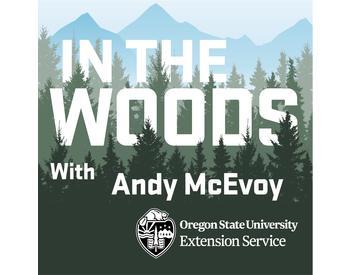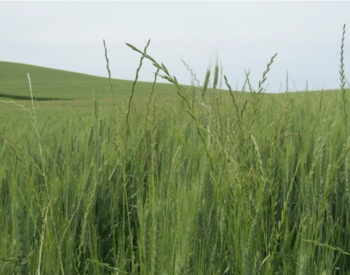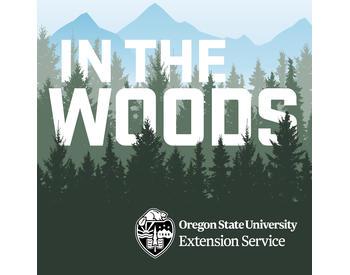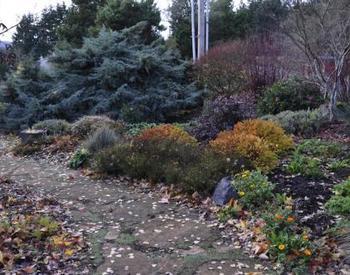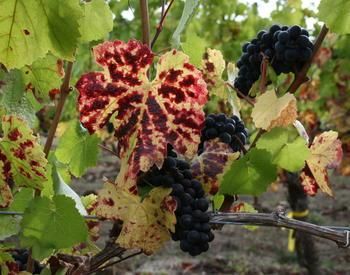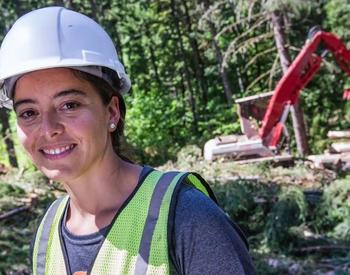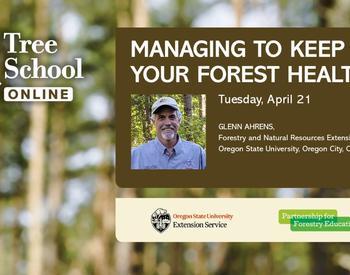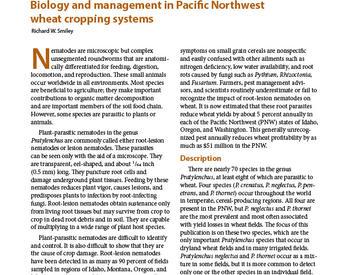Transcript
From the Oregon State University's Extension Service, you are listening to In the Woods with the Forestry and Natural Resources Program. This podcast aims to share the voices of researchers, land managers, and members of the public interested in telling the story about woodlands provide more than just trees.
They provide interconnectedness that is essential to your daily life. Stick around to discover a new topic related to forests on each episode. Hey listeners, we just wanted to take a moment to thank you all for listening to In the Woods. We hope you've enjoyed the episodes as much as we've enjoyed being your hosts. Since we started in 2021, we've produced 26 episodes covering numerous forestry and natural resource related topics. To help us continue to provide quality and relevant content.
We want to hear from you on how we've been doing and get your feedback on our In the Woods podcast series. Do you like the topics we've been covering? Are there topics we are missing that you would like us to cover? How is the quality of the episodes? We have developed a short survey where you can tell us how you feel.
Please go to beav.es/inthewoods-feedback. That's beav.es/inthewoods-feedback or visit our website to access the survey. The survey can also be found in this episode's notes. The survey should only take about five to 10 minutes to complete, and when finished, you'll have the option to be entered into a drawing to win some In the Woods swag.
We really need your help, so please take a moment to fill out this survey. The feedback we receive will help not only with improving the podcast, but also help us in forestry and Natural Resource extension to ensure we are reaching our audiences. From all of us at In the Woods, thank you again for listening.
We look forward to bringing you more engaging content on a wide range of topics from guests with diverse backgrounds, experiences, and expertise.
Alright, welcome back to In The Woods Podcast, presented by the Forestry and Natural Resources Extension Program at Oregon State University. I'm Jacob Putney, extension agent in Northeast Oregon, and your host for today's episode.
I'm excited to be joined today by an extension colleague, Chal Landgren. Chal is formally the Christmas Tree Specialist in the Forestry and Natural Resources Extension Program, as well as a professor in the College of Forestry at Oregon State. He has been with OSU for over 40 years, including 14 years with the extension service, and has extensive knowledge and experience working with Christmas Trees.
Chal, it's great to have you here today. I know you're technically retired, right? OSU just isn't quite ready to let you go. Yeah, there, there's probably two, two reasons, Jake, um, that, uh, I've retired and still working. One is I, I keep hoping to refill the position and work with the new person that comes into the job, um, that's been delayed and, and postponed.
We're hoping that it'll be refilled maybe next year. Um, don't know quite yet. So, I formally retired a year and a half ago, and I've been working half time, or quarter time on, uh, you know, uh, an hourly appointment. And I'm trying to complete some research grants that have been funded and, uh, working to keep Judy Kowalski my technician, working full-time.
Um, I'll be fully retired in seven months and hopefully we'll have a replacement in tow by that time, but that's yet to be determined. But I've got some projects and enjoy what I'm doing and, uh, uh, just enjoying working part-time.
I know we are all hoping that we can get that position refilled too. And I'm gonna guess that there's a lot of folks that don't realize that the FNR extension program even has a Christmas tree specialist, or about all the research that's been done on Christmas trees like breeding growth and uh, pest management.
So Chal, would you tell us a little bit about our, your background and the things you've worked on over your career. Yeah, and I've got to acknowledge that I've had a lot of help over my 40 years of working with Extension and working on Christmas trees. Um, Mike Bondi, Rick Fletcher, John Hart, Gary Chastagner, Steve Webster, and hundreds of grower cooperators have helped over, over my career.
You know, in, in, in terms of my background, Jake, I was, a forestry major in, in college and then went back and got an MBA in in business. Uh, I worked for the US Forest Service for three years out of a little town in California named Platina. Um, started with FNR extension in 1980, working in Columbia County, Oregon, and, and in Cowlitz County, Washington.
Then in 1982, you know, in terms of the Christmas tree direction, my wife went back to work on a Master's and I was left with a lot of extra time on my hands. So we bought 14 acres of ground and had to make the decision of trying, did we want to grow apples or Christmas trees? So we decided to grow Christmas trees on five acres of the property and it sort of, um, that's what has peaked my interest.
You know, ever since 1981 or 1982 in growing Christmas trees was starting our own little farm. Um, some of the projects that we've been, that I've been working on with others over the last 40 years are, uh, one of the longest projects that we've been working on forever has been genetic improvement. We've been moving away from wild collections of seed to seed orchards for Douglas fir, Noble fir, Turkish fir, Nordmann fir, Trojan fir, and have been do working on seed collections in the Republic of Georgia and in Turkey and in, in trying to establish seed orchards across Oregon and Washington to, um, improve the genetic makeup of Christmas trees.
The other area that I've been working on with others over the years has been nutrient management. So when I started with Extension, we were using kind of a, a modified nutrient management guide that was used in filberts and apples. So over the years, with help of others, we've developed guidelines that are very, that are specific to individual species, particularly Douglas fir and Noble fir.
Where we've refined our nutrient guidelines, nutrient management guidelines to those species and have developed a lot of tools for growers to use to grow a better tree. Um, seems like with, with any kind of, uh, forestry or natural resource effort, there's always pests. And in Christmas trees every three years, it seems like we have a new problem, uh, developed.
When I first started, um, Swiss needle cast was a developing problem on Douglas Fir. Over the years we've been, I've been working with problems to control Needle Midge, twig weevils, needle blight. Um, and just a host of other diseases and insect issues that that show up, uh, in, in Christmas trees and in forestry.
A recent project, recent being probably the last five years is is related to climate change. Where we've been having very hot and dry summers. So seedling survival, particularly with Noble fir, has been problematic in the Willamette Valley. You know, some years we've had up to 90% mortality of Noble fir on that first year planting.
So, we've been trying different things to improve seedling survival, you know, which is important in Christmas trees because like forestry, uh, very few properties have access to irrigation. Another area that, uh, we've worked with is sustainability. We've been working with projects to look at, um, ways to minimize the, you know, the need to use insecticides.
Um, particularly on species like Noble fir and, and grand fir. So, um, have been looking at, you know, introducing, um, predator, predator beneficial insects into fields. Um, trying to see if there's some ways we can minimize the use of pesticides. And then lastly, an area that I've been working on with others for a long time has been leader control.
So, Christmas trees like forestry trees have the, have the, uh, advantage or disadvantage that they grow slowly at first and then too fast later on. The perfect tree would be one that grows to about five feet, uh, really quickly and then slows down and grows only a foot a year. So I've been working with others on looking at plant growth regulators to control the length of leaders on particularly Noble fir and Turkish fir so that growers have different tools besides just cutting the tops off.
So that's, that's a quick look at, you know, six different project areas that I and others have been working on in with Christmas.
That's quite the range of topics, uh, and if you haven't guessed it already. Today we're gonna be talking about Christmas trees, and Chal is the expert when it comes to Christmas trees, and Oregon is the largest Christmas tree producing state in the country, and they're an integral part of Oregon's wood products industry.
So I've cut down my fair share of them, but I am certainly no expert on how they grow, Chal. So, let's, uh, let's start with the basics. So, let's talk about the trees themselves, so which trees are grown here in Oregon and what does their lifecycle look like?
Yeah, the two most commonly grown Christmas trees in Oregon and Washington is, are Douglas fir and Noble fir.
And those two species make up probably 90 to 95% of the, of the yearly production of Christmas trees. Um, Douglas fir require, it's a faster growing tree, and it requires somewhere around five, six years depending on the height and, and site at which it's grown. So it's, it's our fastest growing species.
Noble fir requires seven to nine years for, uh, you know, the typical harvest sized tree. Then we've got some other species that have been grown commonly and probably the longest. The other one that's been grown for a long period of time is grand fir. Um, it's sort of intermediate in terms of its growth rate between Noble and Douglas fir a little, a little faster than Noble, a little slower than Douglas.
Um, but we have some new species that we've been introducing into the production in Oregon and Washington. And those are, those are Nordmann and Turkish fir. So the native stands for these trees come from either Georgia, the Republic of Georgia and Turkey, and they generally take a little longer than Noble fir to grow, uh, from 8 to 10 years, uh, to get a harvestable sized tree.
But they have some advantages for growers in Oregon and Washington in that they're resistant to most of the common, um, root rots that plague particularly Noble fir. And they are resistant to some of the insect pests that we have. Um, particularly some of the aphid problems that plague grand fir and, and Noble fir.
So, they have some advantages to, to growers, um, and they have a little bit better survivability that in that first year after planting because they, they establish root systems pretty deeply down into the soil. Uh, but they take a long time to grow and, and they're kind of a new species, uh, for many of the growers and many of the consumers, uh, in Oregon, you know, and in other spots where we export.
So those are our main species. Those, uh, five that I mentioned and we're, there's a species that we're investigating called Trojan fir, that's a close relative of Turkish that, um, looks promising to grow in Oregon and Washington.
And where is that one native to?
It's, it's native to Turkey, but there's, it's a, rather, it's not a widespread species growing in Turkey, unlike, um, uh, Nordmann and, and Turkish fir.
So, there's a, there's two areas in near the, uh, Aegean Sea, in kind of the middle, middle of middle West, part of Turkey that we've done collections for. So, you won't find them in any Christmas tree lot yet, but we've been collecting seed and starting seed orchards for that species. So, looks like Turkish fir, I can't tell it, I can't tell that apart from Turkish fir.
And many consumers and even growers, can't tell Turkish from Nordmann to Trojan. So it's, uh, it, it, they're, they look very similar.
So, um, for the species that are native to Oregon, like Douglas fir and Noble fir and grand fir, uh, are these the same type of seedlings that you would plant out in a forest, like say after a harvest? Um, are these specifically grown to be Christmas trees?
Well, they're the same species, but we have different, we prefer some different traits in Christmas trees than, than, you know, the forest landowners. So, um, and some of those traits that we find important for Christmas trees would be lots of, lots of branches, particularly branches that grow upright.
And for the forest landowners, that would mean more knots and more, more imperfections and wood. So, but we love upright branches and lots of them. We, we like trees with excellent color, which wouldn't be maybe a particularly important trait in, in forest land for forest landowners. Uh, disease and insect resistance would be important for both of us, you know, forestry and, and Christmas tree growers and rapid growing, uh, at least for the first three years of its life. And then slow down, which, which isn't very common in, in any of the species. So, um, and for both forestry and Christmas tree growing, the number of wild collections that happen for, for obtaining seed is getting to be smaller and smaller.
So, like forestry, much of the seed, uh, is coming out of seed orchards that are specifically designed for established forest landowners. And we have a number of seed orchards that have been very specific for Christmas tree traits as well. So, we have, we have seed orchards that have been developed for Douglas fir, Noble fir, and we've got Turkish and Trojan and, and, um, Nordmann coming along and reproducing seed in a few years.
So, we're developing those seed orchards and it'll, those will probably be providing more and more of the seed and seedlings that get planted out.
Uh, going back to leader growth, I imagine the spacing of whorls is important too, um, for the appearance of Christmas trees. And is that controlled or do you try to select for that through genetic improvement?
Yeah, again, you know, the perfect tree, you know, for a Christmas tree would have lots of rural branches and lots of internodal branches because that's what controls the tree's density. So one of the things we measure when we're doing progeny tests is how many, how many buds or rural, rural branches are in each one of those nodal positions.
And then we also look at the density of internodal buds along a leader to try to find trees that fill in faster. So, uh, one of the one of the things that degrades trees in terms of its, its grading. You know, when trees are graded for harvest, are openings where, you know, they're bigger than a small beach ball.
So, if we can minimize that, we can get a higher percentage of number one or, or prime quality trees. So, yeah, those are traits that are at least partially inherited. So those are traits that we're very, uh, very much looking for. One of the, one of the traits that's unique maybe to Christmas trees, uh, besides the ones I've already mentioned, are in our seat orchards.
We also have been testing for needle drop. So for consumers needle drop is, is of course a negative trait that we were trying to avoid. So, uh, Gary Chastagner at Washington State University has, has put together a lab where they evaluate needle loss and how long the trees keep their needles in the winter. So, um, all of the trees that are going into our seed orchards have been tested for keepability, needle loss and keepability.
So, those, that's a fairly unusual trait, at least from a forestry standpoint. That's important to... Yeah, mm-hmm... Christmas tree growers and consumers. Um, let's go through a typical Christmas tree farm here in Oregon. Uh, how does one get started and what does the management system look like?
Yeah, good question.
There's kind of two cycles in Christmas tree growing one sort of a yearly cycle of things that you do every year on a plantation. The other might be sort of a rotational cycle, so you have to do certain things at certain point during the life of, of that particular tree. So in the yearly cycle, if we start with sort of planting, that usually takes place, you know, in February or March, although growers are investigating, doing some fall planting, um, to try to mitigate some of the, the dry summer concerns.
So planting, uh, February, March, and there's kind of a progression that something needs to happen on a farm every quarter. So, you, if we look at planting in winter, weed control would often be the next yearly, um, activity that growers engage in. Uh, or either mowing or some sort of herbicide application to control weeds.
Some species like grand fir and in some cases Noble fir. They'll be insect and some disease control measures that have to be, uh, conducted, usually right, right at bud break. And those would be things like some of the needle cast diseases. The, the treatments that growers use for those are preventative. In other words, you have to get the, the spray on before the disease hits.
So, you have to be ahead of the game with some of these disease, particularly things like Swiss needle cast and rust disease. And it pays to be ahead of some of the, uh, some of the aphid and insect damages that may occur or may not occur. You know, those are sort of a if needed kind of scenario and in late summer on trees that are getting too wide or growing too fast, growers start sharing and doing leader control.
And that usually happens at the point where maybe for Douglas fir, it'll be in year, year two, or for Noble fir in year three, you'll start sharing the sides, uh, with sharing knives or, or clippers or even hand hand pruning. And then when the tree gets to be about four and a half to five feet tall, growers will start keeping the leader from getting too tall.
So, and that keeps the tree from getting from developing too many, uh, holes or openings and improves the grade. So, uh, that's kind of the yearly cycle. The rotational cycle is gonna be longer, you know, depending on the species and the height that you want to be selling trees at.
But again, that would start with planting. And then the activities that are commonly done would be in years two, three, and four. Growers are pruning out the bottom branches on the tree so that there's a, there's a, a handle to put in the tree stands for the consumers in a open spot to. For cutting the tree down and it improves, it improves the air circulation, which mitigates some of the disease problems on trees.
Um, so that basal pruning will start in, you know, years two and three, sometimes into year four. Um, shearing again will take place, uh, beginning in the second or third year of a tree's life. And then towards the end, before harvest, harvest will, you know, occur over usually about a three year, two to three year period for Christmas tree growers.
So, harvest is taking place right now, growers are out busy harvesting trees. Um, you know, if you drive through a lot of the areas, uh, where Christmas trees are commonly grown in the Willamette Valley, you'll see helicopters out there with bundles of trees, uh, being lifted to landings where they may be, some fields, there may be, um, they may be, um, bailed before their helicoptered.
In many fields the the helicopter will take the tree bales to, um, a site where the trees will be wrapped. And then in starting shipping, shipping is going on now. You'll see, you'll start seeing trucks go down the road for, for shipping. Some of the foreign export shipping has probably been going on for almost a month, so...
Oh, wow.
We ship ship trees all over the, you know, Pacific rim. Uh, and that takes a while to arrive at their destinations. But those, those have been started for about at least a month. So, uh, that's kind of the rotational cycle.
I know you mentioned a bunch of them already, but, uh, going back to health issues in Christmas trees, what would be some of the, let's say the most common or the most damaging health issues for our Christmas tree and, uh, what are some approaches for mitigating them?
Yeah, lots of, you know, there's a, the disease and insect problems that we have in Christmas trees are many of the same that, you know, forest landowners, uh, encounter. But some of the, some of the pests that Christmas tree growers focus on are more aesthetic pests that may damage the color of the tree, or, you know, this, the year, the current year's needle growth.
So, um, some of the most common problems that we have in in Christmas trees, if we look at, at look at it by species, Noble fir is very sensitive to phytophthora root rot and annosus root rots. So those are two main production, uh, maladies that Christmas tree growers face. Um, the cure sometimes just simply means that you have either try to eliminate the disease potential or try to grow something else.
So, if the field, if a field is wet, for example, Noble fir will often succumb to phytophthora root rot. So, if the field is wet, growers can do things like, um, improve the drainage by tiling the field. We had that on our own, our own farm, where we didn't realize we had a couple of wet spots, so we, we had to put in drain tile to improve the drainage in those, in those areas. Oftentimes growers of Noble fir realize that annosus root rot, um, which is a common forest, forest disease, uh, gets into the field and so growers may, may look at doing two rotations, let's say, of Noble fir and then either switching to a different species for a couple rotations or trying to remove the old stumps.
Um, so they'll go in with big rakes or uh, root ball removing equipment to get rid of those old stumps, to be able to plant Noble fir after two rotations.
So those two diseases are, are pretty common in Noble fir fields. Growers of species like grand fir, they're often subject to some of the, you know, aphid, aphid pests. So they're looking at. mitigating some of that problem by, by spraying. There's also some canker diseases that affect grand fir uniquely, or white fir that, um, if they get started, growers have to work on either pruning out branches or removing entire, you know, the, the entire tree.
So diseases, we have rust diseases that have alternate hosts, maybe fireweed or, or wild currant. So, and cottonwood. So those, those diseases, there are sprays that you can mitigate the you know, the rust problem with, or you can look at removing some of the host plants that, uh, harbor the, the alternate life cycle for those, those pests.
Then we have issues with some of the needle cast diseases like Swiss needle cast, uh, where growers can, can spray, uh, but anything growers can do to improve air circulation in their fields and try to mitigate the problem is helpful. Then we have things that sort of develop out of, out of the blue.
Uh, twig weevils have been an issue in some species the last few years. Douglas fir needle Midge has, is always been a, a problem that seems to come and go. Uh, so growers have to be on the alert for a lot of these problems. Um, particularly right when the tree is breaking bud because some of the pests and some of the diseases you have to, you have to prevent the infection before it happens.
So, those are just the range of issues that disease and insects cause. There's also been a lot of abiotic issues that have plagued Christmas tree growers and forestry landowners. Um, the heat dome two years ago was a big, uh, a big issue for growers. So when temperatures get up to that 118, 120 degree, problem, you know, temperatures, you know, the south side of the tree can be completely denuded of needles and hopefully the, the buds survived that, that kind of temperature extreme.
Um, but that's been, those have been some of the issues that growers have been facing. And then just the dry, long, hot summers have been, have been, um, problematic for growers of both forestry and Christmas tree growers.
Do you see that trend kind of continuing with things like climate change, um, and what have Christmas tree growers done to try to, um, help mitigate those, those damages from those dry hot summers?
Yeah, great question. Some of the things that growers are, Investigating or, or one would be fall planting. So if we can get the roots established in the fall before, uh, the, the, the hot summers occur, that is likely to help survival. Then I've been working with others on trying to look at a variety of, you know, is there something that growers can do at the time of planting to, uh, improve seedling survival?
And some of the things growers are doing to, to try to improve survival, particularly for Noble fir, have been doing more extensive field preparation. So deep ripping the soil so that it can have a higher, you know, moisture holding capacity of the, you know, in the fields. So that's, that's a practice that more and more growers are are using.
Then we've been looking at is there some sort of soil additive or amendment that we can add at the time of planting to improve, um, survival. So we've been looking at whether microrisal additions or fertilizer additions or some sort of humic acid or moisture absorbing, um, compound. If we add those at the time of planting, can we, uh, improve survival?
We've also been looking at using anti-transpirants sprayed on in the summer to see whether or not that might help. Um, there's some treatments that closed the, the stomates on the needles on Christmas trees, and we've looked at some treatments doing those kinds of sprays. We've also been looking at, uh, adding shade, shade cloth at the time of planting to keep some of those temperatures down.
And we've looked at using wood chips at the base of seedlings to improve the moisture holding capacity of the soil. So that's a long introduction to some of the things that we've been trying, what we've found that seems to be effective had been largely the wood chips has been probably the most effective treatment at the time of planting.
A lot of the, the moisture absorbing compounds and, and, um, humic acids and some of those microrisal additions haven't really improved survival. They may, they may have an impact on, on a little bit better growth fertilizer in particular. Um, but survival, to improve survival it seems like the wood ships and shading have been the most consistent additions that we can do in Christmas trees, and it probably work in, I suspect it would work in forestry as well.
Um, so we've improved, you know, depends on the year, but we've had a 20% improvement in survival, uh, with the use of wood chips. Um, the shading has improved the survival a little bit in some years, the anti-transpirant sprays haven't made any difference, um, to survival, uh, in our, in our trials anyway. Um, so those are some of the treatments that have been useful.
We've also been looking at, you know, are there cheaper ways to provide water to the trees for just that first year of growth? So, growers have been very creative in looking at, um, different types of drip irrigation systems that they can work off of tanks, and just simply working out tree basins around the tree where you can drive tractors through your field and fill those basins with water once or twice a growing season.
Uh, because nothing works like water to help help survive a dry, dry hot summer. I know if we could get one or two rainfall events during the summer, we'd be, we'd be blessed.
I imagine the wood chips are one of the more cost effective approaches too...
Yeah... compared to some of those fertilizers or sprays.
Yeah, they've been, they've been very effective.
We've had some years where we've had a decent amount of rainfall. Some of the fertilizer additions have been, have, have improved growth quite a bit and we've got some trials where we're looking at how much did, did some of the fertilizer bags and, and, and, uh, some of the sprays at treatment, because most of the trees in, in Christmas tree plantings are mechanically planted.
So, a tractor will pull a, a planter through the field and, you know, so they're, and, and growers are looking at, are there's some sort of a tank system where you can spray the root as it's, as it's being planted with some, with some solution. So we're still looking, but the wood chips have been probably the most consistently effective means of improving survival.
Have any producers, uh, installed drip lines like they do for, uh, hazelnut orchards.
Yeah, you know, the drip lines, you know, certainly if, if a grower has access to a fir, to a, excuse me, a irrigation system, um, the drip lines are, are, are great. Um, sadly, most, most fields are dry land. So, the drip irrigation systems that some of the growers have put in work off of tanks and gravity.
Mm. So that they're maybe watering, you know, a row of a hundred trees or something like that, and then moving the drip system over to water them. And you know that that's effective. It's just expensive and time consuming. So, but growers, uh, you know, have had three to four years of pretty poor Noble fir survival. So, they're looking at, you know, whatever they can do to improve survival, and in some cases that means they're moving production from Noble fir to something like Nordmann or Turkish or Douglas fir to get trees, uh, to make it through that, especially that first year.
Well, uh, let's switch gears here and talk about the industry. Uh, how did it get started here in Oregon and how kinda, how it has it progressed and what does it look like today?
Yeah, the industry kind of started in, in the east around Pennsylvania and Michigan, and it was largely using wild trees, um, that were cut in the forest and, and, um, brought into town.
One of the funny stories, one of the, one of the folks that started that industry along a rail line decided that Michigan was way too cold. So they, they moved to California and started harvesting wild trees out of the cascades and Sierras. So, but that's been a long time. Um, so the industry started, started back east, and then it moved north and west.
So, uh, up until, you know, the, the sixties, it was largely a, an industry taking trees out of the wild or thinning trees out of the forest and selling them, you know, wherever you can find a good market. You know, maybe down into California. But then a few growers, particularly in Washington and Oregon, started investigating different means of making Christmas tree growing more of a plantation enterprise.
So, some growers, you know, in, in Oregon, Washington started initially shearing Douglas fir and then, um, holiday tree farms and others looked at moving the whole industry down, so it was plantations of, you know, acres and acres of trees where they're treated like a farm, like a crop.
So, you know, in the, probably fifties, Shelton, Washington was the, was the center of Christmas tree production because their, they're, they have sandy soils and the tree grows slowly, naturally. And this was largely with Douglas fir. But as time moved on, growers investigated shearing and fertilizing and machine planting, and the industry moved to, to Oregon, kind of around Corvallis.
And then growers started investigating, doing the same thing for Noble fir. You know, it's, it was largely a forest harvest crop and thinning. So growers, uh, one of the bigger plantations started at Noble Mountain outside of Salem, started by Crown Zellerbach. Um... Oh wow... and so there's thousands of acres of, of production, of Noble fir that Crown Zellerbach sold out to some innovative, uh, growers out of, of Salem and Washington.
So, uh, so started with Douglas fir being kind of plantation grown and then has moved to, uh, Noble fir and right now Oregon is, is still the largest producer in the country. And we're harvesting, oh, depends on the year, but it, right now it's right around, you know, three, three and a half million trees a year.
Wow. And most of those are, are Douglas fir and Noble fir. Um, Washington is in about fifth place, but South Carolina and, and Michigan and Pennsylvania are, are producing quite a few trees and North Carolina's right now, producing lots of Fraser fir and hopefully we won't lose our number one spot to North Carolina.
But, um, uh, they've been successful in growing some, some Fraser fir and shipping that all across the east. So, the the markets for Oregon grown Christmas trees or Washington. Uh, Southern California and the Southwest are our largest kind of shipping markets where we ship to stores outside of Oregon and Washington.
Mexico is our largest export destination. I think we're harvesting it somewhere, or shipping somewhere in the neighborhood of about 600,000 trees into Mexico. And then there's a whole host of countries along the Pacific Rim and, and, uh, and Hawaii that we're shipping trees into.
Yeah, so of those, what, three and a half million trees, uh, how many of those are sold here like locally or like a you cut? Um, or how many of them get exported? You said 600,000 go to Mexico. Do they go to any other countries? Um, or is it mostly around the Pacific Rim?
It'd be mostly the Pacific Rim. I mean, we ship, there are trees that probably get shipped to almost every state in the country, but once, once we get past, you know, somewhere around the Mississippi, it gets pretty expensive to ship Noble fir across the country.
You know, and Fraser and Balsa for, uh, you know, are probably the big trees back east. You cut farms, um, you know, and local farms are, are very important to, to our Oregon production, but we sell, we produce more trees than we can use in Oregon.
So, shipping outta state's important. Yeah. For the industry. And you have your own Christmas tree farm, right? So if someone was interested in starting a farm of their own, what advice would you give them?
Probably one of the best pieces of advice I got when I was starting was I, I volunteered my services to, as an apprentice to some neighboring Christmas tree growers.
So, you know, I could work with one, one of the, one of the producers and learned a little bit about harvesting, and another one to learn a little bit about shearing and managing a farm. And so if you have the opportunity to volunteer, um, or an apprentice with a neighbor, that's probably a, a great way to learn.
Um, our little farm is about five acres. And it's probably largely a five acre experiment. So rather than trying some of the crazy ideas that we come up with to, uh, grow trees, I'll try 'em on our little farm first and see if they work before subjecting other people to some of these ideas. So, um, you know, we've got lots, I've got lots of different experimental ideas.
Many of which don't work out. So it's, and it provides a little bit of extra credibility to, you know, to, to do, you know, to do work on, uh, with other growers. So that's been a great way to learn. You know, if growers are looking for information about what to do, you know, we've got, I've got a lot of information that Judy Kowalski has helped put up on our website at North Willamette from, you know, all the publications that OSU has on on growing trees.
Our nutrient management guide, the Pacific Northwest handbooks about insects and disease and weed control. Or, or you can access through the website. We've got videos on shearing and managing, uh, particularly Noble fir and Douglas fir, uh, publications on groaning Douglas fir and, and Noble fir. And the common species that we grow in the Northwest.
Um, and some information about results of progeny tests and web, you know, web presentations or presentations that we've done for Christmas tree growers are, you know, are available on that website. So, um, up, so look at doing some apprentice apprenticing with neighbors and getting some background looking in, background reading on how to grow the trees and then plan ahead because seedlings are getting harder and harder to come by.
It's very rare now where you can say in February that you think you might want to grow trees and find some seedlings. So you almost have to plan two to two to three years ahead in terms of ordering trees.
So, takes some planning and some preparation.
Yeah, we'll make sure to get those resources linked to this episode, but, um, yeah, I agree nothing could really beat that firsthand experience either.
Yeah. Yeah. It really helped, really helped me in knowing, knowing what, uh, what was coming down the pipe in terms of harvesting and whatnot.
Uh, I know you mentioned a lot of the research that you've worked on, um, but what is the current research, uh, today? What, what is the big topic that researchers are focused on when it comes to Christmas trees?
In terms of what I'm working specifically on, you know, we've got some, we've got trials looking at fall planting, um, and compared to spring winter planting, we're still continuing to look at methods of, uh, mitigating the, you know, excessive heat and dry summers on Noble fir.
So we're gonna put in, we're gonna be putting in some new trials, uh, this next spring, and we're finishing up a project where, we're looking at some new species of particularly Nordmann fir and some Trojan fir. So those are being grown up at a nursery in Washington.
So we'll be planting those out this next, this next spring, and following those through a rotation. So those are some of the seed and seedling, some of the seed that we collected, uh, in trips to Georgia and Turkey. That we'll be following to see if we can find some trees that are better than the ones we have here now.
But those, you know, seed orchards from those trees will be quite a few years away. Mm-hmm. Well, we're just about out of time here, so we're near in the end. Uh, but I wanna make sure we don't miss anything. Um, do you have any parting thoughts on Christmas trees, management, uh, the industry or what's next? The future?
Well, like in terms of my hopes, my hope is to get the position, my position filled by somebody before, before I depart the scene. Um, you know, the whole area of genetic improvement spans people's careers. So... Yeah... um, I'm hoping that whoever if we get into that position can continue on the genetic improvement and the seedling survival work that, that, you know, that we've sort of been doing over the last decade.
I mean, the genetic improvement was started long before I was on the scene and hopefully, uh, long after I'm gone because it does take a while.
Well, I think about the forestry side too, and we're just now getting to the point where some of the realized gain trials are like available to be measured, you know, from progenies that were started, you know, 30, 30 or so years ago.
So it's a long time. Yeah. For the forestry side at least, especially at uh, those rotations. Yeah, you know, we have shorter rotation periods, but it still takes as long to get developed. So it's, it's not quick. I mean, no, you know, some grower, you know, we had hopes of things like somatic embryogenesis where we could multiply individual seeds, um, into, you know, whole plantations, but that's never never has worked out to be cost effective.
We were looking at rooted cuttings being important for Douglas fir and all of all of the years I've been working, it still comes down to seed orchards and having seed to be able to produce nice looking trees. So, um, I think we'll be there for a while. Well, Christmas trees are a huge part of the forest and wood products industry in Oregon.
So, thank you so much to for sharing your expertise with us today, Chal. Uh, with Christmas right around the corner, we thought this would be a fun episode for those interested in this holiday's tradition. Uh, if any questions came up while you were listening today, or if you'd like to learn more, please drop us a comment or send us a message on our website.
Uh, as usual, we have to conclude each episode with what we call our lightning round or a few questions that we ask each of our guests.
So, Chal, we'll start with the first question here. Uh, what is your favorite tree? In this case could be Christmas tree and forest tree. Okay, well, I'm kind of torn between Turkish fir and Trojan fir. So those are not your typical forest tree, so, um... If you can tell I'm apart, right? Yeah. Yeah. And maybe it's good you can't, because you could just call 'em all Turkish, you know? I don't know.
Yeah. But those are, that's my favorite. What about, uh, Christmas trees aside? What would you say your favorite forest tree is? Oh, I'm probably partial to Western Red Cedar. Yeah, that's a good one. Um, the next question here is what is the most interesting thing you bring with you in the field?
Probably plastic bags and an LED powered hand lens. What do you use the plastic bags for? To put samples in to... Oh, samples. I don't if I don't what it is, which is often the case. Yeah. I have to send it into the plant clinic or up to, uh, Gary Chastagner. So, um, the plastic bags are important. Plastic garbage bags.
Yeah. And lastly, what resources would you recommend to our listeners if they're interested in learning more about Christmas trees, management, pest issues and things like that? I know you mentioned some of them. Yeah, I, I would refer people to the website, so we'll have that listed on, on the podcast. Um, and talk to your neighbors.
There's nothing like getting firsthand experience from someone nearby. So, those are probably the, the two or three places I would send people for information and help.
Well, Chal, thank you again for being here today. Uh, it was really great to have you. I really learned a ton. Uh, I grew up in Clackamas County and I remember seeing acres and acres of Christmas tree farms.
I think next time I head over there, I'll definitely have a different perspective. Uh, when I look at some of those Christmas tree farms. Before we go, this is just a reminder to give us your feedback by filling out our survey. The survey can be found at beav.es/inthewoods-feedback. That's beav.es/inthewoods-feedback.
The survey can also be found on our website. Well, this concludes another episode of In the Woods. Thank you all so much for listening. Don't forget to subscribe and we will see you all next time.
Thank you so much for listening. Show notes with links mentioned on each episode are available on our website inthewoodspodcast.com. We would love to hear from you, visit the tell us what you think tab on our website to leave us a comment, suggest just a guest or topic, or ask a question that can be featured in a future episode. And, also, give us your feedback by filling out our survey.
In the Woods was created by Lauren Grand, Jacob Putney, Carrie Berger, Jason O'Brien and Stephen Fitzgerald, who are all members of the Oregon State University Forestry and Natural Resources Extension team. Episodes are edited and produced by Kellan Soriano. Music for In the Woods was composed by Jeffrey Hino and graphic design was created by Christina Friehauf.
We hope you enjoyed the episode and we can't wait to talk to you again next month, until then what's in your woods?
In this episode, Jacob Putney and Chal Landgren discuss the history and science behind growing Christmas trees in Oregon. Landgren is the former OSU Extension Christmas Tree Specialist.




